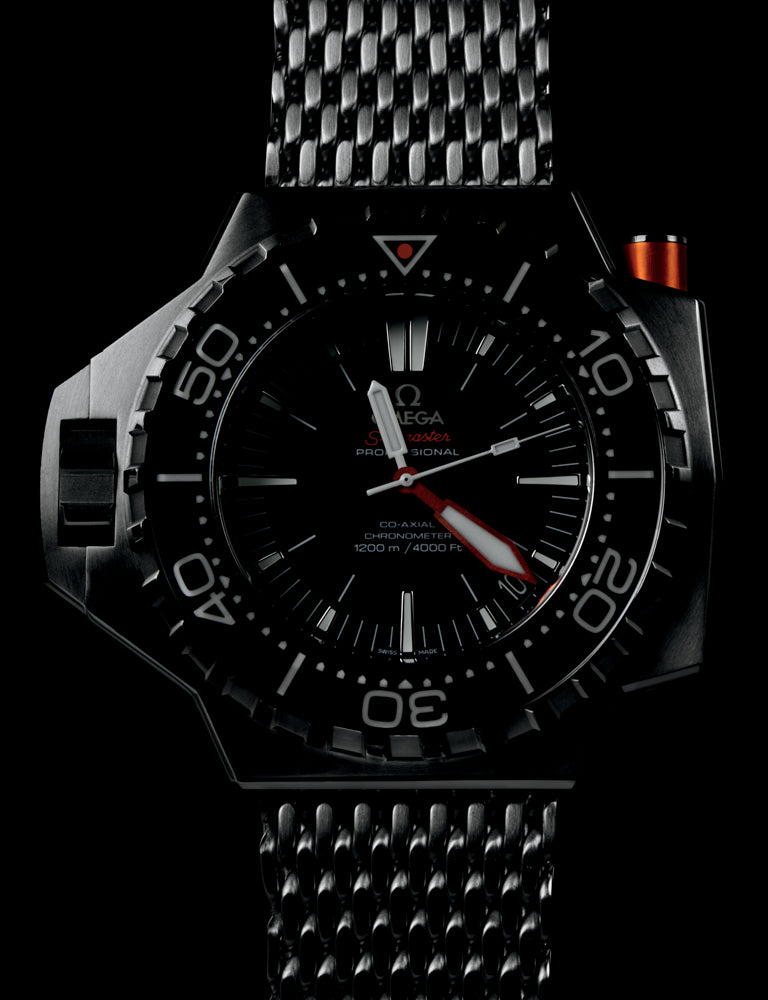
Divers Watches
DIVERS WATCHES


A good friend and seasoned collector once asked me, “when you think of the word ‘watch,’ what do you see?” It was the first time someone had posed such a loose question to me about something so dear – and the result shocked me, just as it shocked him. The watch that came to my mind was a dive watch – a 1970s Rolex Submariner, to be exact. It wasn’t a complicated Patek Philippe pocket watch from the dynasty of a great banking fortune, nor was it an elegantly curved wrist chronograph from Vacheron’s hey-day in the 1940s – it was a 39mm dive watch, with just one moving part – a rotating bezel. It occurred to me that day that the dive watch might just be the most universally appreciated category of wristwatch on earth, despite the obvious data that indicates so few wearers actually go diving.

What it is about the dive watch that makes it the obvious choice for a daily wearer, as well as the companion of everyone from:
◆ James Bond of the 1950s (Sean Connery famously wore an early “Big Crown” Rolex Submariner both as Bond and off-screen)
◆ Steve McQueen (while the Heuer Monaco is most publicly associated with McQueen thanks to his role in the film LeMans, his daily watch was in fact a 1970s Rolex Submariner reference 5512,) to
◆ James Bond of today (Daniel Craig wears an Omega Planet Ocean in the last three Bond films, and off-screen wears a vintage Omega Sea- master 300)?
One potential answer to this question is that undoubtedly, those that are attracted to mechanical watches today, in a time when the wristwatch is nothing if not superfluous to daily function, have an overgrown or more developed appreciation for history. And it was the dive watch that, as early as the 1930s, began to shape the political landscape that we know today – literally altering 20th century history. Of course, this means the dive watch was, throughout the last 80 years or so, arguably the most important tool to the world’s great militaries.

Many of the design traits first implemented by the early Panerais have translated to today’s commercial examples.
The Rolex crafted Panerais of the Italian Royal Navy were built originally in 1936 – on the eve of the second world war – and given to “Frogmen” of the Decima Flottiglia Mezzi d’Assalto – or Italy’s clandestine group of human torpedoes and assault swimmers. Under the fascist rule, this group was responsible for the sinking of over 72,000 tons of allied warships. Many of the design traits first implemented by the early Panerais have translated to today’s commercial examples – such as the oversized crown guards and wire lugs. But, while Panerai can be credited with supplying some of the first militarized dive watches, it was not until 1953 that the dive watch as we know it today came to be, all thanks to the introduction of not one, but two category-creating watches.
The Basel World of exactly 60 years ago saw Blancpain unveil what is customarily believed to be the first dive watch as we know it today. Dubbed “50 Fathoms” it bore a rotating, graduated bezel to allow for easy timing underwater, luminous hands and markings, and a thick case waterproof to 100 meters. Around the same time, Rolex would unveil its own diver with rotating bezel called the Submariner. It would be the Submariner and 50 Fathoms that would go on to become the standard issue watches to countless militaries over the next six decades. The 50 Fathoms would become standard issue to the German, French, and Polish navies (with a small batch built specifically for US forces) while the Submariner would be built directly for the British Ministry of Defense, and Tudor Submariners would accompany both the US Navy and most famously, the French Marine Nationale on their missions.


During the 1960s, innovation in dive watches hit its stride. The decade of the diver was inaugurated by the historic plunge to the greatest depths known to exist, by Captain Don Walsh and Jacques Piccard. Inside a small vessel known as the Bathyscaphe Triest, the two descended over seven miles into the Mariana Trench — the deepest point in the world’s ocean — and returned to the surface safely. They did so with a special Rolex prototype attached to the outside. This “Deep Sea Special” remains the most lauded diver of all time, a veritable piece of lore. But, this historic dive would simply set the scene of a decade of diving deeper and deeper.
This was the decade that saw the development of the helium escape valve — a small uni-directional gasket that allows a watch to decompress quickly after a particularly deep dive – a product conceived by Rolex with the help of none other than Jacques Cousteau himself. Cousteau actually played a role in the development of numerous dive watches, including Omega’s famous PloProf (short for Plongeur Professional) and many of Doxa’s dive pieces, to which he would later attach his name. It was also during the 1960s that Rolex would put crown guards on its cases and develop the “trip-lock” crown, an incredibly robust, triple grooved stem that allowed for an incredibly tight seal at the crown – traditionally the weakest point of any waterproof case.

These esoteric and eccentric traits of vintage divers remain highly sought after in today’s watches. Vulcain, for example, still makes its Nautical Cricket with an alarm and decompression table on its dial. The rotating, graduated bezel has now become industry standard — though they are now uni-directional and feature complex mechanisms to ensure they don’t move without purpose.
Helium escape valves have also become the norm for dive watches rated to 500 meters or more. The dedicated dive watch has taken on a whole new life with the development of ultra high- end tool watches such as the Audemars Piguet Royal Oak Offshore Diver and the IWC Aquatimer Chronograph.
Through it all, the dive watch, with its chunky case, odd rotating bezel and luminous dial, remains the one universally adored sport watch not only by sportsmen, but by businessmen. The Submariner with a suit is all but a uniform in the world’s major cities.


“It occurred to me that day that the dive watch might just be the most universally appreciated category of wristwatch on earth, despite the obvious data that indicates so few wearers actually go diving.”
Early examples of divers — from Rolex, Blancpain, Jaeger-LeCoultre, etc — regularly sell for the price of a luxury automobile. The dive watch is something special, more so than the pilot’s watch, or the racer’s watch, or even the watch designed specifically to be worn every day. The diver’s watch represents the best of mechanical watchmaking, from a time when watches weren’t luxuries, they were necessities.
And I’ll bet now, if you were to close your eyes and think of the word “watch,” you too would picture something originally designed to be taken into the deep blue, even if you’re nothing but a desk diver yourself.


